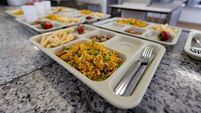School meals fuss throws the baby out with the bathwater

There is no such thing as a good food or a bad food. It is the overall diet that counts, not the inclusion or exclusion of a few specific foods that might be high in fat, salt and/or sugar. Picture: iStock
As the summer draws to a close and back-to-school looms in the horizon, parents will no longer have to compete in the annual back-to-school photography Olympics of perfectly curated lunch boxes as all primary school kids can now avail of the free hot meals scheme.
However, 350 new schools due to join the scheme will be put on hold due to proposed new rules from the Government’s procurement department.
The minister for social protection, Dara Calleary, confirmed that foods high in saturated fat, sugar, and salt will be removed from the programme from September. Up to now, such foods have been permitted once a week but only when selected by a child’s parent(s).
What has triggered the sudden hysteria around food ingredients and processed foods? Nobody argues with a pilot about how to fly a plane, but everyone thinks they’re an expert on nutrition after watching a Netflix documentary, or by following social media influencers who pretend to be experts.
There’s a growing rhetoric in the past year suggesting that food labels are misleading and that the information can’t be trusted. Nothing could be further from the truth.
It seems some wellness influencers have positioned themselves as experts, but have clearly never read any of the EU food regulations. Nor do they understand how to interpret nutritional information and health claims on the label.
Food labelling is highly regulated. People who confidently read lists of ingredients into the void in supermarkets have a lot to answer for as their videos amount to scaremongering of perfectly safe ingredients.
Many people also believe that if is there is a long list of ingredients with words that are unfamiliar, sound scary, or may be difficult to pronounce, then the food is deemed to be "bad" according to them. Pyridoxine, ascorbic acid, and phylloquinone are just Vitamins B6, C, and K. Nothing to be afraid of, trust me.
The nutritional value of an uneaten school lunch is zero. Compromise is key.
There is no such thing as a good food or a bad food. It is the overall diet that counts, not the inclusion or exclusion of a few specific foods that might be high in fat, salt and/or sugar.
Using such a simplistic approach would result in very nutritious processed foods being incorrectly categorised and banned — such as cheese. Unless a child’s diet consists of just one or two foods, then it is the overall combination of foods in the diet that will determine if it is nutritionally adequate to support growth and development.
Even the HSE’s own food pyramid has processed high in fat, sugar, and salt foods on the top shelf; they are allowed once or twice per week as part of a healthy diet, so why are they being banned in school meals?
Parents have the option to completely avoid whatever meals they personally perceive to be unhealthy by just not ordering them. Alternative meals are always available.
What about neurodivergent children and those with sensory issues around food texture and colour? How are they going to be impacted by the exclusion of such foods? Nuance is needed here instead of the sledgehammer approach.
Parents are supposed to be gatekeepers for their children’s health. There is an onus on parents to seek advice from reliable sources.
A recent study carried out in DCU, which analysed 67,000 videos on social media platform TikTok, found that only 2.1% of nutrition content was accurate; the remainder was misleading or potentially harmful.
Another study in Ireland found that only 6.1% of nutrition-related posts were classified as being of good quality.
It’s so disheartening to see health professionals such as experienced paediatric dietitians / clinical nutritionists share their expertise, but are often torn to shreds — particularly on Instagram. The way so many people leap to defend influencers by trolling actual experts is cult-like behaviour. Of course, everyone is entitled to their own opinions — but not to their own facts.
Two of the most important ultra-processed foods are infant formula, which is essential, and fortified breakfast cereals which are highly nutritious and affordable for so many people living in food poverty.
We should not assess school lunches from a point of privilege. When this scheme was initially launched in 2019, it focused on providing school lunches in Deis schools only.
Now that all children are being included, as a cost-of-living measure, the voice of the privileged is driving the narrative. It’s turning into a circus.
It would be wrong to assume that a meal which contains a few chicken goujons or fish fingers is unhealthy or problematic. No single food could skew nutrition intake to that extent unless the child consumed no other foods or beverages.
For context, today I analysed a school lunch from one provider’s gluten-free menu. It was a hot wrap containing baked chicken breast goujons and some ketchup. The analysis showed that the meal was low in saturated fat, low in sugar, high in fibre, and high in protein.
The meal qualified for those nutrition claims as the nutritional composition met the strict criteria set out in EU food law.
Most providers’ websites have the nutritional information readily available, and I certainly haven’t seen any meals that set off alarm bells. Where’s the hysteria coming from? Would it perhaps be that school principals haven’t time to deal with this and are asking parents, who probably get their own nutrition information from social media, for assistance in choosing a supplier?
However, children only attend primary school for 183 days per year. We also need to exclude weekends and school holidays, so the likely contribution of school lunches to a child’s overall nutritional intake is only around 12%. The focus should be on helping parents to optimise the other 88% of their children’s nutritional intake.
In 2017, the Government issued a detailed document on nutrition standards for school meals which clearly sets out the rules. Why was the nutritional composition of the menus not requested or audited until now? If the HSE or minister has some new scientific evidence that allowing one processed high in fat, sugar, and salt
food option once a week in a school lunch is detrimental to a child’s health, then I’d love to see it.
Are we in danger of throwing the baby out with the bathwater with the proposed changes to the hot school meals scheme? It would be much better use of State resources to audit the allergen declarations on the school menus.
Children are the largest cohort of the population with food allergies, which ranges from 2% of younger kids to 5% of older children. Consuming a processed high in fat, sugar, and salt food once a week carries no risk to a child, but inaccurate allergen labelling could lead to a potentially life-threatening situation.
Nutrition is a science, not an opinion. Context matters.
- Niamh O’Connor is an independent Coru-registered dietitian and nutritionist with 31 years’ experience, has a background in hospital clinical nutrition and dietetics, paediatrics, and has also worked as a research nutritionist. Since 2012, she has specialised in menu analysis, allergen labelling, EU food legislation, and currently provides professional support for hospitals, restaurants, and one provider in the free school meals scheme (the latter amounts to about one hour per week averaged over the year).
















